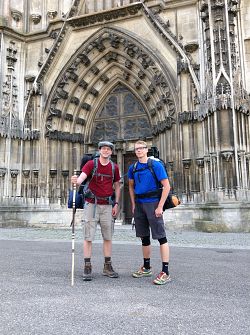Take a pilgrimage to enhance your spiritual life

Luke Stager
Pope Francis has called us this Jubilee Year to be Pilgrims of Hope. We often hear that our faith is a journey, or you will hear people speak of our Lenten journey, or even “this life’s pilgrimage.” But what is a pilgrimage, actually?
A pilgrimage is usually defined as a journey to a holy site, or a journey of religious significance. Indeed, the primary purpose of pilgrimage is a spiritual one. One of the hurdles I had to get over when I began learning and completing my own pilgrimages is that the prayer is not at the destination, but that the actual act of walking or journeying can itself be a prayer.
The Scriptures are rife with examples of spiritual journeys. The very identity of Israelites is one of exile and journeying, the most obvious examples being the journey through the desert to the Promised Land and the return from exile in Babylon. Even in the New Testament, we hear about the Magi traveling a long distance to see the newborn king, the Holy Family making their trek to Egypt and back, and even Jesus himself goes on the pilgrimages to Jerusalem for the Feast of Booths and for Passover, eventually “setting his face toward Jerusalem” (cf. Luke 9:51) as he prepares for his impending passion and death.
Pilgrimages can be framed with multiple spiritual perspectives, whether it is penance for sins; making a journey for healing (e.g. the healing waters at Lourdes); solidarity with the stranger and the exile; following the footsteps of Jesus, the apostles or other saints; or the ultimate realization that heaven is our true home and that any physical pilgrimage we take is emblematic of our life’s pilgrimage toward heaven.
During this Jubilee Year, many people are making a pilgrimage to Rome and walking through the holy doors. Most people, however, are unable to make the long and expensive trek to the Eternal City.
Pope Francis, in his Bull of Indiction for the Jubilee Year, tells us that “The Christian life is a journey that calls for moments of greater intensity” and “pilgrimage helps us rediscover the value of silence, effort, and simplicity of life.” How can this be lived out in our own community?
One may undertake their own pilgrimage in their local Church. Many parishes or groups create their own Seven Churches pilgrimage in their own diocese. The Seven Churches pilgrimage officially takes place in Rome on Holy Thursday night, when the faithful walk from church to church after the liturgy and visit the Blessed Sacrament at all the altars of repose. In Portland, Ore., a few parishes band together to create a walking pilgrimage through the downtown streets from church to church, with various devotions prayed along the way. Some people here in our own Diocese of Salt Lake City will drive to different parishes on Holy Thursday night in a similar vein.
Even if not undertaking such a pilgrimage on Holy Thursday night, making visits to other churches and undertaking special devotions can be a good Lenten practice. A parish can get a large group together and walk on pilgrimage. For example, on their patronal feast day, St. Mary of the Assumption Parish in Park City does a yearly four-mile walk from Old St. Mary’s downtown to the new parish church. In Oregon, where I am from, groups walk the 19 miles from St. Joseph’s Church in Salem to Mount Angel Abbey in a day, while a group, many of whom could not walk that far, remain behind in the church as prayer warriors, keeping vigil with the psalms all day.
When I was in college, my best friend showed me a book by Hilaire Belloc called The Path to Rome. In it, Belloc recounts his decision to walk to Rome from Toul, France in 1901. He says, “I will walk all the way [to Rome] and take advantage of no wheeled thing; I will sleep rough and cover 30 miles a day.”
So inspired were my friend and I by Belloc’s resolve and his accomplishment that we decided we, too, would one day undertake this pilgrimage, which we completed in 2014.
Since then, I have not been able to do another such trek, but I have found other ways of making pilgrimage a part of my prayer and spiritual life. What Pope Francis says about silence, effort and simplicity of life I have learned firsthand.
I would encourage anyone who wishes to engage with the Jubilee year to find ways to be a pilgrim in your own local Church. Make a walk to a neighboring parish; try to create your own Seven Churches pilgrimage, or pray for those who are traveling, and make offerings for the stranger and the exile.
Luke Stager is a teacher at The Madeleine Choir School. He will present “Pilgrimage to the Triduum: Seven Churches and the Easter Vigil Psalms” on Saturday, March 1, 10:15 am to 12:30 p.m. in St. Ambrose Parish’s social hall, 1975 South, 2300 East, SLC. Cost: $10, cash only, at the door.
© Copyright 2025 The Diocese of Salt Lake City. All rights reserved.

Stay Connected With Us